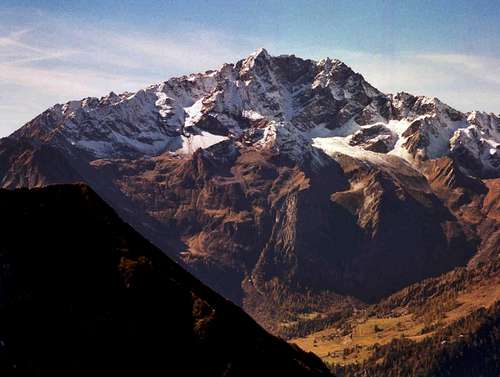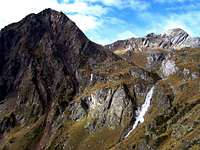|
|
Mountain/Rock |
|---|---|
|
|
45.82590°N / 7.87857°E |
|
|
Piedmont, Val d'Aosta |
|
|
Hiking, Mountaineering, Via Ferrata |
|
|
Spring, Summer, Fall |
|
|
10892 ft / 3320 m |
|
|
Overview
An hideout for Witches.Corno Bianco("White Horn", in english) is the highest summit of the watershed between piedmont and Valle d’Aosta apart from Monte Rosa massif.
Although the border line between the two regions runs along the North ridge, the main summit of the mountain is located entirely in Piedmont, in the territory of Valsesia, the valley that takes the name of the river that streams from the glaciers of the south face of Monte Rosa.
Surrounded by a big crown of satellite summits this massive rocky mountain is not visibile from the villages below, only scrambling till the highest meadows it finally appears above the other peaks like an huge castle of rock.
A real labyrinth of ridges climbs to the top of the mountain forming numerous pinnacles and enclosing steep gullies and narrow cirques. Ancient glaciers, whose remains are still visible under the impressive north wall or in the upper part of Puio gully, carved the flanks of Corno Bianco creating its actual dramatic figure.
Due to the complexity of its topography and to its remote position the routes to corno Bianco are long and articulated, an ascent to the summit is a kind of trip through almost all the faces of alpine environment, across woods, meadows, fields of snow and debris, along the shores of sweet lakes or on the edge of narrow ridges.
Its remote position, together with its fierce aspect, is the cause of the numerous stories invented by the inhabitants of the area, one of these tells that its summit was used by witches as an hideout while another one tells of a wild man living alone under Puio gully, in the cirque where the two lovely lakes called Thaily are located, that used to descend in the villages below to rob and kill.
Faces
- from Cima Mutta, E- from Tagliaferro, NE
- from Quintino Sella hut, N
- from the Lyskamm, Monte Rosa, NW
- from Bianco lake, SW
Getting there
The trailhead in Valsesia are Alagna and Riva Valdobbia.To get there the quickest route follows the A26 Milano-Genova Highway till the exit of Romagnano, then goes on along the main road of Valsesia.
Alagna is the last village of the valley, Riva is just a few kilometers befor.
The trailhead for the Lys side (Val D'Aosta) is instead Gressoney, easy reachable from the Point Saint Martin exit of the Torino-Aosta Highway and then following the main road of the Valley. Gressoney is the last village.
Huts
Abate Carestia (2200m), important support point along the most followed route to the summit from Riva Valdobbia.The trailhead is the locality called Ca' Janzo, at the entrance of Vogna Valley, reachable by car from Riva Valdobbia.
The trail is very easy and perfectly indicated, during July and August the hiking can be very warm due to the exposure to South.
The hut is located under Punta delle Pile, near the entrance of Rissuolo valley.
Bivacco Ravelli(2500m), under Uomo Storto pass, in Otro Valley, used to climb the mountain from Aagna.
The trail to Ravelli starts directly from Alagna and crosses the beautiful Otro valley passing by the Walzer villages of Follu and Scarpia.
Passed the locality of PianMisura the path enters the canyon of Rio Cuttiri and finally reaches the hut on the summit of a pinnacle on the hydrographic right of the river(south).
Bivacco Gastaldi(2600m), in Netscho valley, in the remote cirque under the north flanks of Ciampono and Rissuolo peaks, used to start from Gressoney and climb the North ridge.
The trailhead is the locality called La Trinitè.
It's also possible to start from the Gabiet Impound, at 2200m, reachable from Gressoney with a cable-lift.
Routes
Note: the difficulties are reported following the european UIAA scale, both for rock climbing and for global evaluation of the routes.North Wall
The North wall of Corno Bianco is a large bastion of rock
The big pillar under the summit that dominates the entire wall has an height of 650 meters and is one of the hardest rock climbing route of Valsesia. This pillar has been climbed for the first time during 1942 but the most repeated route, the direct one, has been climbed in 1962 by Giorgio Bertone, a strong mountaineer of Valsesia that became famous during the 60's and 70's for his performances in the Monte Bianco range. The first ascension of this route during winter belongs to Silvio Mondinelli and another guide of Alagna during the 80's.
The route is evaluated TD (very difficult, UIAA scale), the rock is not always firm, but is good on the hardest part.
The repulsive gully on the right of the pillar has been climbed in 1932, during the first ascension of this wall, but this route has never been repeated, it is in fact very dangerous for rock falls.
High Route “Tullio Vidoni”(for expert hikers with some I and II), A fantastic route that turns around the mountain crossing the solitary and wild valleys at its feet.
This path is dedicated to Tullio Vidoni, an Italian climber that died during a solitary Ski-mountaineering journey to the Little Altar Pass, in Valsesia.
It normally takes three days.
This route is sometimes hard to find, especially for the part of the trail that crosses under the wild south flank of Corno Bianco, in the area under 'Vallone del Forno', where the trails have almost desappear.
This route passes by Gastaldi, Carestia and Ravelli huts. You can start both from Alagna, Riva or Gressoney. The most of the technical difficulties are concentrated in the part that from "uomo storto" pass crosses to Gastaldi hut and then to Rissuolo pass, under the wild NW flanks of Netscho and Ciampono peaks.
External Links
Alagna homepageThe home page of Alagna. With info about the accomodation.
Gressoney homepage
The home page of Gressoney. With info about the accomodation.
Corno Bianco
Ferruccio page on Corno Bianco, with lovely pictures of the crossing of the mountain by ascending from rissuolo cirque and descending across Puio gully.
Lovely slide show of images taken around the mountain
Tullio Vidoni route on the Italian Alpine site
About Tullio Vidoni and the route whit his name that crosses the valley around Corno Bianco, with images and maps, very useful.
History of Corno Bianco huts
All the huts of Corno Bianco with also historic informations and nice pics.
Gastaldi hut
Otro valley homepage
The site of Otro Valley, you also find here a description of the path to Ravelli hut.
Gastaldi hut
Ravelli hut
Ravelli hut informations.
Carestia hut
Carestia hut inforomations.
Tullio Vidoni trek
Trip report of the Tullio Vidoni route with maps and photos, very nice.













